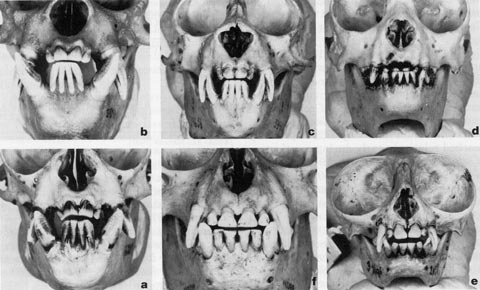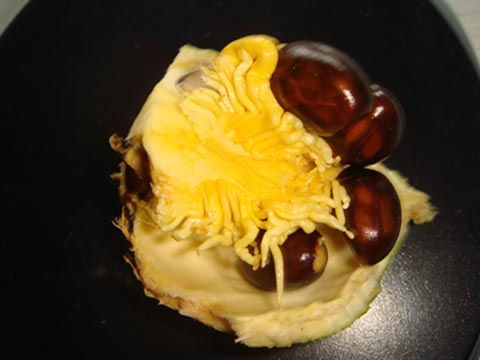Marilyn A. Norconk, PhD
Fieldwork Photos
Marilyn A. Norconk
Feeding ecology and mechanical properties of fruit and seeds ingested by white-faced and bearded sakis
Sakis and bearded sakis are modern representatives of an ancient clade of seed predators in South America. Dating from 15-18 million years ago, their peculiar dentition (Fig 1) is evident even in the earliest species. View the movie of subadult male white-faced saki, Jack, as he opens a Gustavia augusta fruit to gain access to the thick, yellow, fleshy funicles (Fig 2) that hold the seeds in place.
Sakis spend from 40% to 90% of their feeding time each month on seeds. The advantages of seed predation lay in nutritional qualities of seeds, an expanded window of food availability compared with ripe fruit, and apparent reduction of food competition with other primate species. Despite the body size differences between white-faced sakis and bearded sakis, there appears to be no difference in the toughness of fruit they open or seeds they masticate. Instead, there are differences in habitat use and ranging patterns that result in very little overlap in individual trees or species that are used by these two closely related species. The liabilities of seed eating may be related to a body metabolism that is dependent on a high fat diet. Sakis may be particularly vulnerable to forest disturbance and loss of preferred feeding species through logging, mining, and other forms of habitat destruction.
We (Warren Kinzey, Terry Gleason, Brian Grafton, Nick Robl and myself) have collected data on fruit resistance to puncturing and seed resistance to crushing since 1986. Protected fruit like those ingested by sakis are often passed over by other fruit-eating monkeys until they are riper and softer. Tables 1 and 2 summarize data collected in Suriname (Raleighvallen-Voltzburg) from 1986-87; Venezuela (Lago Guri) from 1989-2002; and Suriname (Brownsberg) from 2004-present. We have tested 116 species of plants from 33 plant families. Research supported by NSF BNS 90 20614 (to Warren G. Kinzey); NSF SBE 98-07516 (to M. Norconk).
See related publications:
Kinzey and Norconk, 1990; Norconk et al., 2009; Norconk and Veres 2011 papers on the Brownsberg Nature Park research page, and
Kinzey and Norconk, 1993; Norconk, 1986; Norconk et al., 1998 papers on the Lago Guri page.
| |
|
| 3-year old Jack planes the base of Gustavia augusta with his lower
incisors
to open this labor-intensive fruit. (video by M. Norconk) |
 |
|
Fig 1: In this illustration from Kinzey (1992:AJPA 88:499-514), the sakis are (a) uacari, (b) bearded saki, and (c) white-faced saki, and (d) titi monkeys. The non-saki monkeys are (e) night monkey and (f) spider monkey. Note the massive and widely flaring canines and narrowed procumbent incisors of the 3 sakis. Titis are in the same subfamily as the sakis and uacaris, but exhibit fewer specialized dental traits. The massive canines allow them to open very tough fruits. The widely flaring canines aid in gaining access to fruit that is larger than their gape width. In the video, notice how Jack uses his incisors to plane away the bottom of the fruit and then pulls portions of the pericarp through his incisors. |
 |
Fig 2: The object of Jack's attention: the pedunculated funicles attach multiple seeds of Gustavia augusta (Lecythidaceae) to the wall of the fruit. Species of the Lecythidaceae are often ranked high in the diets of sakis and uacaris. They are classically well-protected fruit, often with thick, fibrous, tough fruit covering that is removed by teeth and hands before they can gain access to the interior of the fruit. (photo M. Norconk) |
Table 1: We used a device to measure puncture resistance to fruit pericarp and crushing resistance to seeds to estimate the degree of mechanical protection of foods eaten by sakis and non-seed eating spider monkeys (see Kinzey and Norconk, 1990). Foods ingested by spider monkeys and two saki species are alphabetized by family. Note that legumes (Fabaceae), Sapotaceae, and Bignoniaceae are particularly diverse in our samples. Of these 33 plant families, about half are shared among two or three primate species. The average toughness of fruit pericarp is often low, but maximum values separate the sakis from the spider monkeys, and to some degree, white-faced sakis from bearded sakis. To provide some scale for these values the puncture resistance of an uncooked beet is 0.9 kg/mm2, a lime is 2.2 kg/mm2, an intact almond ranged from 11 to 25 kg/mm2 and an intact hazel nut ranges from 15 to 42 kg/mm2. I have fed hazel nuts to white-faced sakis. They can open them, but it takes them more than 15 minutes to do it. At their upper limit, hazel nuts are harder than anything we have measured from wild sakis. |
| Plant family | # plant species |
avg value kg/mm2 |
primates using the resources | max value kg/mm2 |
species ingesting hardest fruit |
|---|---|---|---|---|---|
| Annonaceae | 2 | 1.64 | Ateles, Chiropotes | 3.20 | Chiropotes |
| Apocynaceae | 3 | 1.04 | Ateles, Chiropotes | 1.04 | Chiropotes |
| Bignoniaceae | 13 | 3.30 | Chiropotes, Pithecia | 10.20 | Chiropotes |
| Bombacaceae | 1 | 0.58 | Ateles | 0.88 | |
| Boraginaceae | 1 | 0.14 | Ateles | 0.14 | |
| Burseraceae | 3 | 0.39 | Ateles, Chiropotes, Pithecia | 1.21 | Chiropotes |
| Capparidaceae | 1 | 4.10 | Pithecia | 4.10 | |
| Celastraceae | 3 | 1.73 | Pithecia | 5.59 | |
| Chrysobalanaceae | 6 | 3.16 | Ateles, Chiropotes, Pithecia | 37.80 | Chiropotes |
| Connaraceae | 2 | 1.75 | Pithecia | 2.73 | |
| Euphorbiaceae | 4 | 5.28 | Ateles, Chiropotes, Pithecia | 17.27 | Pithecia |
| Fabaceae | 22 | 3.88 | Ateles, Chiropotes, Pithecia | 27.30 | Chiropotes |
| Guttiferaceae | 1 | 0.68 | Ateles | 0.72 | |
| Humiriaceae | 1 | 0.63 | Ateles | 0.63 | |
| Lecythidaceae | 5 | 4.04 | Ateles, Chiropotes, Pithecia | 18.18 | Pithecia |
| Loganiaceae | 3 | 2.53 | Ateles, Chiropotes, Pithecia | 2.05 | Pithecia |
| Meliaceae | 4 | 2.07 | Chiropotes, Pithecia | 4.09 | Pithecia |
| Menispermaceae | 1 | 2.85 | Pithecia | 3.33 | |
| Moraceae | 7 | 0.51 | Ateles, Chiropotes | 3.21 | Chiropotes |
| Myristicacae | 4 | 1.90 | Ateles, Pithecia | 4.54 | Pithecia |
| Opiliaceae | 1 | 0.81 | Pithecia | 0.81 | |
| Passifloraceae | 1 | 1.16 | Pithecia | 1.36 | |
| Polygalaceae | 1 | 0.88 | Chiropotes | 1.62 | |
| Polygonaceae | 1 | 1.14 | Pithecia | 1.14 | |
| Rubiaceae | 4 | 0.57 | Pithecia | 1.11 | |
| Sapindaceae | 2 | 1.74 | Chiropotes, Pithecia | 3.44 | Chiropotes |
| Sapotaceae | 11 | 2.90 | Ateles, Chiropotes, Pithecia | 33.84 | Chiropotes |
| Simaroubaceae | 1 | 0.92 | Chiropotes | 1.11 | |
| Solanaceae | 1 | 0.45 | Pithecia | 0.91 | |
| Steculiaceae | 1 | 5.05 | Chiropotes | 6.43 | |
| Tiliaceae | 1 | 2.48 | Chiropotes | 2.48 | |
| Verbenaceae | 2 | 7.09 | Chiropotes, Pithecia | 32.80 | Chiropotes |
| Vochysiaceae | 2 | 3.67 | Chiropotes, Pithecia | 5.23 | Chiropotes |
| Plant family | # plant species |
avg value kg/mm2 |
primates using the resources | max value kg/mm2 |
species ingesting hardest fruit |
![]()